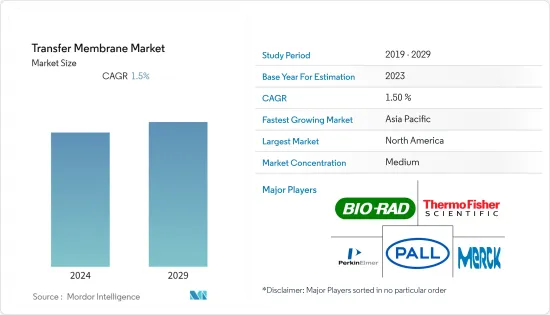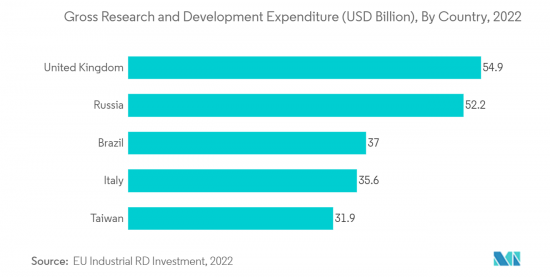PUBLISHER: Mordor Intelligence | PRODUCT CODE: 1405711

PUBLISHER: Mordor Intelligence | PRODUCT CODE: 1405711
Transfer Membrane - Market Share Analysis, Industry Trends & Statistics, Growth Forecasts 2024 - 2029

The Transfer Membrane Market is expected to register a CAGR of 1.5% over the forecast period.
The emergence of new and evolving SARS-CoV-2 variants fueled the need for change in the form of innovative and more adaptable diagnostic approaches for SARS-CoV-2 infection detection. On the other hand, due to new variations and variable symptoms across infected persons, creating rapid and sensitive testing tools became difficult. According to the data from the Journal Annals of Medicines published in February 2022, novel vaccines and medicines were continually being explored to elicit an immune response capable of effectively targeting SARS-CoV-2 and its variations. Such studies indicated the need for new therapeutics for targeting diseases. Therefore, it was observed that the pandemic had a significant impact on the market studied. However, currently, the market has reached a pre-pandemic nature and is expected to witness strong growth in the coming years.
The market is primarily driven by the increasing investment in R&D by pharmaceutical and biopharmaceutical companies and the development of new therapeutics for targeting chronic diseases. According to the European Commission Industrial R&D Investment prediction, data updated in December 2021, the United States planned to spend more than USD 679 billion on research and development in 2022. It was anticipated that China would spend roughly USD 551.1 billion on R&D in 2022. Hence, the high investment in R&D is believed to propel market growth as R&D opens doors for diagnostic research.
Furthermore, the growing prevalence of autoimmune diseases and infectious diseases and the increasing focus on the development of novel drug therapies based on DNA and RNA are projected to boost market growth over the forecast period. As per the data from CDC and National Lupus Registries published in April 2021, an estimate of the number of systemic lupus erythematosus cases in the United States was 72.8 per 100,000 person-years. Therefore, the growing prevalence rate of autoimmune diseases is expected to increase R&D activities; in turn, the demand for transfer membranes is anticipated to upsurge. Eventually, these factors are expected to fuel the target market growth over the forecast period.
However, the availability of alternative methods for protein transfer with high efficiency and automation is anticipated to hamper the market growth.
Transfer Membrane Market Trends
Western Blotting Segment Expected to have Lucrative Growth Over the Forecast Period
Western blotting is a widely known and used test in cell and molecular biology. The test helps to detect the specific type of protein from the complex mixture of proteins that are extracted from the cell. This test has gained attraction in the market due to its specificity, low cost, and ease of use. Western blot test has a wide range of applications in medical diagnostics, such as the diagnosis of diseases such as BSE (Bovine Spongiform Encephalopathy), FIV (Feline Immunodeficiency Virus), HBV (Hepatitis B Virus) infection, and Lyme Disease, among others. Generally, this test is used as a confirmatory test for the above-mentioned diseases after the ELISA test is done with a positive result. For instance, in July 2021, for Lyme Disease, the US FDA suggested that the two-tier protocol use an ELISA test initially and then the specific western blot test for the confirmation of diagnosis if the results of the ELISA are positive. Hence, these factors will have a positive impact on the target market over the studied period.
Previously, western blotting was commonly done to confirm the HIV diagnosis. However, the Centre for Disease Control and Prevention (CDC) in the year has recommended discontinuing the Western blot test for HIV as there are novel techniques that came up in the market for HIV detection. Furthermore, studies have suggested that western blot is a priority test for the diagnosis of diseases such as BSE (Bovine Spongiform Encephalopathy) and FIV (Feline Immunodeficiency Virus). Therefore, due to the above-mentioned factors, it is projected that the target segment will witness a high CAGR during the forecast period.

North America is Expected to Dominate the Market Over the Forecast Period
The North American region is anticipated to have a significant market share owing to a large number of R&D activities, huge investments in developing new drugs, and support from public and private organizations for research. Moreover, the growing prevalence of chronic diseases coupled with rising targeted diseases in the region is anticipated to boost regional growth. According to the American Cancer Society's 2022 annual report, it was observed that there were an estimated 1.9 million new cancer cases in the United States during 2022. Hence, such a factor will positively influence the target market growth in the forecast period.
Research and development budgets of pharmaceutical companies have also increased in the last few years, owing to the increasing focus on regulating markets, complex molecules, and therapy segments. In the United States, pharmaceutical companies spend more money, time, and energy on R&D than others. According to the 2021 PhRMA Annual Membership Survey, the total amount spent on research and development by its member companies reached USD 91 billion. Therefore, the rise in R&D activities in the region is expected to increase the demand for transfer membranes, which, in turn, is expected to aid the growth of the market studied in the region over the forecast period.
Transfer Membrane Industry Overview
The transfer membrane market is moderately competitive, with the presence of a few key players operating in the market, including Merck KGaA, PerkinElmer Inc., Pall Corporation, Thermo Fisher Scientific, Bio-Rad Laboratories Inc., Abcam PLC, General Electric, Santa Cruz Biotechnology Inc., Axiva Sichem Biotech, Macherey-Nagel, GE Healthcare, and ATTO Corporation.
Additional Benefits:
- The market estimate (ME) sheet in Excel format
- 3 months of analyst support
TABLE OF CONTENTS
1 INTRODUCTION
- 1.1 Study Assumptions and Market Definition
- 1.2 Scope of the Study
2 RESEARCH METHODOLOGY
3 EXECUTIVE SUMMARY
4 MARKET DYNAMICS
- 4.1 Market Overview
- 4.2 Market Drivers
- 4.2.1 Growing Prevalence of Targeted Diseases and Introduction of New Treatment Technologies
- 4.2.2 Growing Public and Private Investments in Research
- 4.3 Market Restraints
- 4.3.1 Lack of Skilled Professionals
- 4.3.2 Availability of Alternative Technologies
- 4.4 Porter's Five Force Analysis
- 4.4.1 Threat of New Entrants
- 4.4.2 Bargaining Power of Buyers/Consumers
- 4.4.3 Bargaining Power of Suppliers
- 4.4.4 Threat of Substitute Products
- 4.4.5 Intensity of Competitive Rivalry
5 MARKET SEGMENTATION (Market Size by Value - USD million)
- 5.1 By Type
- 5.1.1 Nitrocellulose Transfer Membrane
- 5.1.2 Polyvinylidene Fluoride (PVDF) Transfer Membrane
- 5.1.3 Nylon Transfer Membrane
- 5.2 By Transfer Method
- 5.2.1 Dry Electrotransfer
- 5.2.2 Semi-Dry Electrotransfer
- 5.2.3 Tank Elelctrotransfer
- 5.3 By Application
- 5.3.1 Western Blotting
- 5.3.2 Southern Blotting
- 5.3.3 Northern Blotting
- 5.3.4 Others
- 5.4 By End User
- 5.4.1 Academic Research Institutions
- 5.4.2 Pharmacuitical and Biotechnological Companies
- 5.4.3 Others
- 5.5 Geography
- 5.5.1 North America
- 5.5.1.1 United States
- 5.5.1.2 Canada
- 5.5.1.3 Mexico
- 5.5.2 Europe
- 5.5.2.1 Germany
- 5.5.2.2 United Kingdom
- 5.5.2.3 France
- 5.5.2.4 Italy
- 5.5.2.5 Spain
- 5.5.2.6 Rest of Europe
- 5.5.3 Asia-Pacific
- 5.5.3.1 China
- 5.5.3.2 Japan
- 5.5.3.3 India
- 5.5.3.4 Australia
- 5.5.3.5 South Korea
- 5.5.3.6 Rest of Asia-Pacific
- 5.5.4 Middle-East and Africa
- 5.5.4.1 GCC
- 5.5.4.2 South Africa
- 5.5.4.3 Rest of Middle-East and Africa
- 5.5.5 South America
- 5.5.5.1 Brazil
- 5.5.5.2 Argentina
- 5.5.5.3 Rest of South America
- 5.5.1 North America
6 COMPETITIVE LANDSCAPE
- 6.1 Company Profiles
- 6.1.1 Merck KGaA
- 6.1.2 PerkinElmer, Inc.
- 6.1.3 Pall Corporation
- 6.1.4 Thermo Fisher Scientific
- 6.1.5 Bio-Rad Laboratories, Inc.
- 6.1.6 Abcam plc
- 6.1.7 General Electric
- 6.1.8 Santa Cruz Biotechnology, Inc.
- 6.1.9 Axiva Sichem Biotech
- 6.1.10 ATTO Corporation
- 6.1.11 Macherey-Nagel
- 6.1.12 GE Healthcare
7 MARKET OPPORTUNITIES AND FUTURE TRENDS




